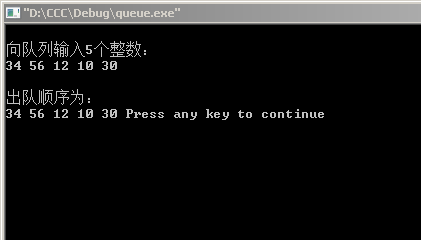源代码:
#include <stdio.h>
#include <stdlib.h>
#define MAXSIZE 100
typedef struct cycqueue
{
int data[MAXSIZE];
int front,rear; //声明队列的头指针和尾指针
}CycQue; //队列的数据类型
//初始化循环队列
void InitQueue(CycQue *CQ)
{
CQ->front=0;
CQ->rear=0;
}
//判断队列是否为空
int EmptyQueue(CycQue *CQ)
{
if(CQ->front==CQ->rear)
return 1; //队列为空,即为真
else
return 0;
}
//入队操作
int EnQueue(CycQue *CQ,int x)
{
if((CQ->rear+1) % MAXSIZE == CQ->front) //判断队列是否已满
{
printf("队列已满!\n");
return 0;
}
else
{
CQ->rear=(CQ->rear+1) % MAXSIZE;//如果队列没满,尾指针向后移动一个单元
CQ->data[CQ->rear]=x;
return 1;
}
}
//出队操作
void OutQueue(CycQue *CQ)
{
if(EmptyQueue(CQ)) //首先判断队列是否为空
{
printf("空队列!\n");
}
else
{
CQ->front=(CQ->front+1) % MAXSIZE;
}
}
//取栈顶元素
int GetHead(CycQue *CQ)
{
if(EmptyQueue(CQ))
return 0;
else
return CQ->data[(CQ->front+1) % MAXSIZE];
}
int main()
{
CycQue CQ;
CycQue *q=&CQ;
int i,n,e;
InitQueue(&CQ);
printf("\n向队列输入5个整数:\n");
for(i=0;i<5;i++)
{
scanf("%d",&n);
e=EnQueue(&CQ,n);
}
printf("\n出队顺序为:\n");
for(i=0;i<5;i++)
{
if(!EmptyQueue(&CQ)) //!代表非
{
n=GetHead(&CQ);
OutQueue(&CQ);
printf("%d ",n);
}
else
printf("\n空队列!\n");
}
return 0;
}
运行结果:
